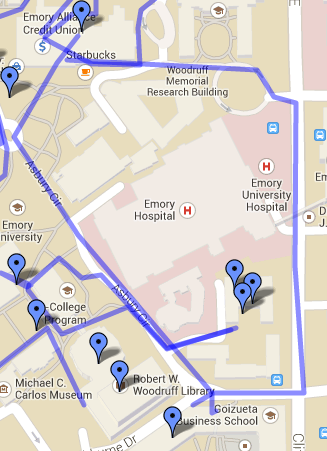For the accessibility evaluation, I decided to evaluate my own route, from Dobbs University Center to the Goizueta Buiness School. The reason why I chose my own route was because I wanted to see the downsides of my analysis and research. Surprisingly, there were many more flaws than I thought.
First was the length of each of the routes. Although the ‘accessible’ route had its benefits, its negative was that the route takes much more time. It is true that the disabled would feel more at ease, but the specific route takes up more time than the ‘inaccessible’ route. In all, in order to receive accessibility, one needs to give up time.
After carefully taking both routes to evaluate, there was one factor that I did not identify in the first analysis. I have previously stated that the accessible route is flat and smooth, since it is on the main road. However, there are downsides to the main road. Not only do automobiles and smokers cause an air pollution on the main road, but there also is all different types of noise from people, cars, hospitals, and many more. In all, the ‘accessible’ route is much more hectic than the ‘inaccessible’ route.
These downsides are ones that cannot be ignored when talking about an accessibility of a route. Although the ‘accessible’ route was built for those that are disabled, there are many more factors to consider to label the road accessible.
First was the length of each of the routes. Although the ‘accessible’ route had its benefits, its negative was that the route takes much more time. It is true that the disabled would feel more at ease, but the specific route takes up more time than the ‘inaccessible’ route. In all, in order to receive accessibility, one needs to give up time.
After carefully taking both routes to evaluate, there was one factor that I did not identify in the first analysis. I have previously stated that the accessible route is flat and smooth, since it is on the main road. However, there are downsides to the main road. Not only do automobiles and smokers cause an air pollution on the main road, but there also is all different types of noise from people, cars, hospitals, and many more. In all, the ‘accessible’ route is much more hectic than the ‘inaccessible’ route.
These downsides are ones that cannot be ignored when talking about an accessibility of a route. Although the ‘accessible’ route was built for those that are disabled, there are many more factors to consider to label the road accessible.

 RSS Feed
RSS Feed